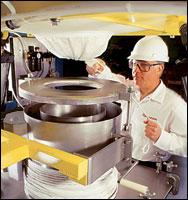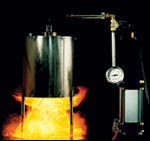
There are five components to every documented grain elevator explosion: fuel (powdered grain), an oxidizer (air), containment of the fuel and oxidizer, dispersion of the mixture and ignition—in this case, a concentrator roller bearing that seized due to a lack of lubrication. As a conveyor belt continued to roll over it, the roller’s temperature spiked to 500?F, more than enough to ignite the layered grain dust inside the roller.
Granted, the amount of grain dust available to fuel the DeBruce explosion far exceeds the raw materials used in a year at any American food plant. The 20.7 million bushels of wheat stored in the elevator’s 410 silos were sufficient to meet all of America’s bread-consumption needs for almost six weeks. But a situation in which combustible dust particles generated by kernels rubbing together while being conveyed in an enclosed space is repeated on a daily basis in bulk handling situations throughout the country. Smaller scale explosions happen with some frequency, and processors increasingly are evaluating their systems to ensure that worker safety isn’t compromised and equipment damage doesn’t occur.
When explosions occur in bulk food-handling processes, local fire departments usually handle the incident and the event is not catalogued, notes Vahid Ebadat, an engineer with expertise in controlling electrostatic hazards and dust explosions. “But every one of them has the potential to be massive,” says Ebadat, a vice president with Chilworth Technology Inc., a Monmouth Junction, N.J., testing lab. “If a small explosion could happen, so could a massive one.
“There’s plenty of information on the hazards of liquids but very little on solids, and many foods are explosive if ignited,” he adds. “Sugar and flour have been around as long as man, but you cannot base safety on published information about those ingredients’ combustibility because particle size and moisture content will be different from batch to batch.” Processors need to know the ease of ignition for the ingredients they handle in bulk and the severity of any explosion that might result. “By just looking at the dust, you don’t know how combustible it is,” Ebadat says, and label declarations such as “mildly flammable” add little to understanding and control. Industry groups such as the National Food Processors Association are working on the issue, but greater understanding is needed, particularly as copacking and other outsourcing arrangements increase the likelihood that companies have to deal with products and ingredients with which they are unfamiliar.
For example, supersacks used in packaging operations “could become highly charged during filling,” says Ebadat. “If there is a solvent chemical nearby, you could have an ignition.” Antistatic bags and groundable bags are two potential solutions, and international standards are evolving to help food companies recognize and minimize potential hazards.

Sanitation and safety
The 2,000-lb. tote is a relatively new packaging option in food, though its advantages have resulted in rapid ascendancy over bulk containers in the last two decades. Automation advances continue to be made, with dust-free handling an area of particular focus.The transfer of material from bulk bags to process, storage and packaging equipment without contamination to the material or the plant environment is both a safety and a sanitation issue. “Dust-free transfer of materials saves time and reduces costs for housekeeping and equipment maintenance,” notes David Boger, sales manager for Flexicon Corp., Bethlehem, Pa. Even more than food safety, those issues are driving bulk food handlers to reassess their handling systems and find ways to minimize the problem of dust. “The equipment maintenance and clean-up savings can be so significant that a lot of companies don’t go through a cost analysis before installing a telescoping tube to control material discharge,” Boger says.
Iris valves often are used to control the discharge of bulk ingredients into a hopper and prevent the creation of dust into the air. Flexicon’s Tele-Tube telescoping tube takes control to a higher level with a double-wall system that eliminates the potential for contamination during transfer. When coupled with features like a vacuum dust collector, high-integrity clamping rings and pneumatically powered hoists for potentially explosive materials, the telescoping tube makes possible a higher degree of dust-free material transfer.
“The problems of dust and sanitation cut across all industries, but the interest in the food segment for these solutions has been particularly widespread,” says Boger. Refinements are ongoing, based on feedback from users. For example, heavier duty handles on the clamping mechanism were incorporated after one client’s handles bent during use.
Once a plant installs sanitary bulk bag discharging equipment, it must also develop sanitary protocols according to equipment capabilities and limitations, unique requirements of the process and the materials’ ability to support bacterial growth. Rigid adherence by personnel to these procedures, as well as to plant hygiene requirements in general, are crucial to ensure that the sanitary capabilities of bulk handling equipment are fully realized.

Magnetic attraction
Metal contamination in bulk material handling goes beyond the slivers that metal detectors are designed to address. Magnetic separation units may become necessary to winnow metal chunks in raw materials or to remove blades and other pieces of equipment that break off during processing. Grain millers have used magnetic separators to remove tramp iron since the 1940s, and technical advancements have greatly improved the ability of those systems to remove metal fragments. “Fifteen years ago, the best you could hope to get out would be a wrench,” says Dave Heubel, manager of separation products at Eriez Magnetics, Erie, Pa. “Now, we can remove stainless steel from the product flow.”Rare earth elements such as Neodymium ushered in a new era in magnetic force in the 1980s, and the chemical makeup of magnets made with those elements has improved dramatically since then. Circuit design also has boosted the ability of magnetic separation units to hold more energy and therefore attract more materials, increasing their utility in protecting both people and machinery.
Sixty years after the company was founded, Eriez Magnetics still sells the bulk of its magnetic separators to rice and grain millers, Heubel says, but greater performance has made the devices useful in other food-related applications, as well. Rendering companies have become customers, and ingredient suppliers contact him when food companies threaten to drop them because of chronic metal issues.
Clean-in-place separators have become available in the last 10 years to automate the magnet-cleaning function. Even if CIP isn’t cost effective, manual wiper systems simplify the maintenance challenge. Cleaning grate magnets used to be a tedious, labor-intensive job today. “It’s almost like opening a sock door: push, pull and you’re done,” says Heubel.
Bulk processing and packaging places specialized demands on conveying systems, and a number of improvements have been introduced. High deflection vibratory feeders can now convey leafy lettuce and other products that defeated these systems before. The reason: deflection upward on the feeders has increased from one-sixteenth inch to as much as one-quarter inch. That imparts enough motion to the belt to prevent the bottom layer of lightweight materials from absorbing all the energy and preventing the top layer from moving.
Eccentric drives have also come into play, varying the forward and backward motion of the belt, according to Eriez’s Mike Latimer. When the forward motion is slower than the backward motion, materials are conveyed more gently, he says.
The precision of weigh belt feeders also has improved dramatically. Gravimetric feeders can control ingredient flow to within 0.25 percent accuracy, compared to 2 percent accuracy with volumetric feeders, says Kathy Hunter, marketing director for Pitman, N.J.-based K-Tron International. That level of control can mean rapid payback when spices and other costly ingredients are involved, she points out.
Compact size, fast conveying speed and the gentle action of weigh belt feeders make them especially applicable in the food industry, where the appearance and condition of ingredients can be compromised by auger feeders, Hunter says. K-Tron recently introduced an open frame version of its weigh belt feeder for food applications. It features automatic and continuous online taring of the belt to reduce maintenance and manual calibration. Stainless steel enclosures and a conveyor assembly that slides out for easier maintenance and sanitation increase its utility in bulk food handling.
Sanitation and safety are driving forces in today’s food industry, so it’s no surprise that bulk processors are paying them close regard.
Fortunately, systems that address those concerns continue to be developed and refined.
For more information:
Mike Latimer, Eriez Magnetics Inc., mlatimer@eriez.com,
814-835-6000
David Boger, Flexicon Corp., dboger@flexicon.com,
973-467-5570
Kathy Hunter, K-Tron International, 856-589-0500


